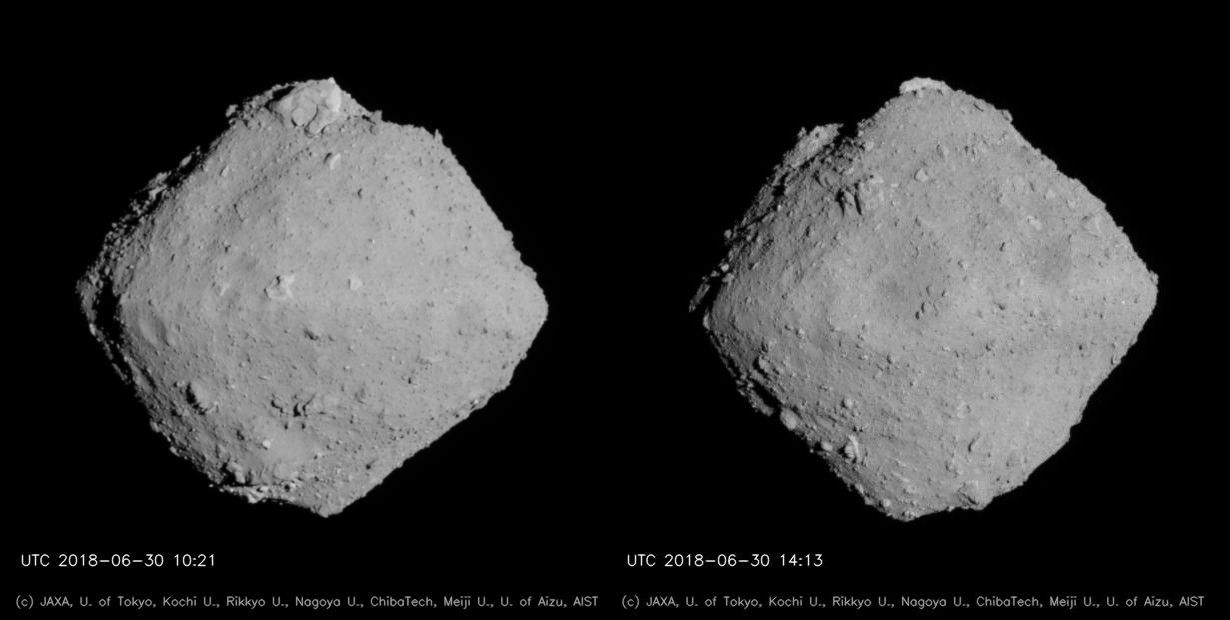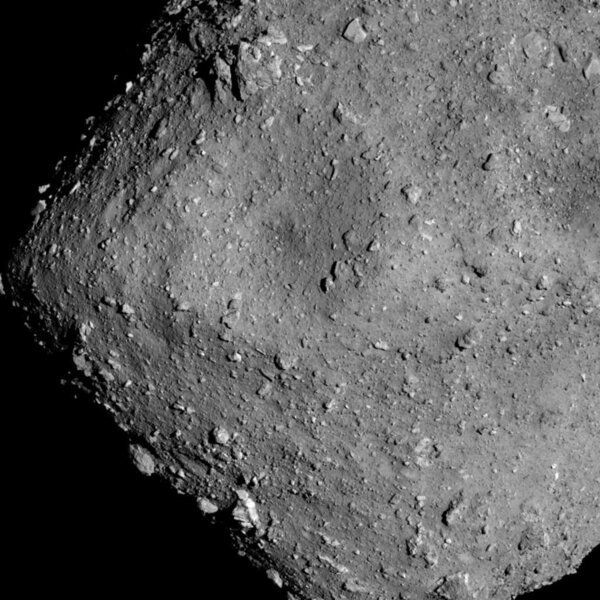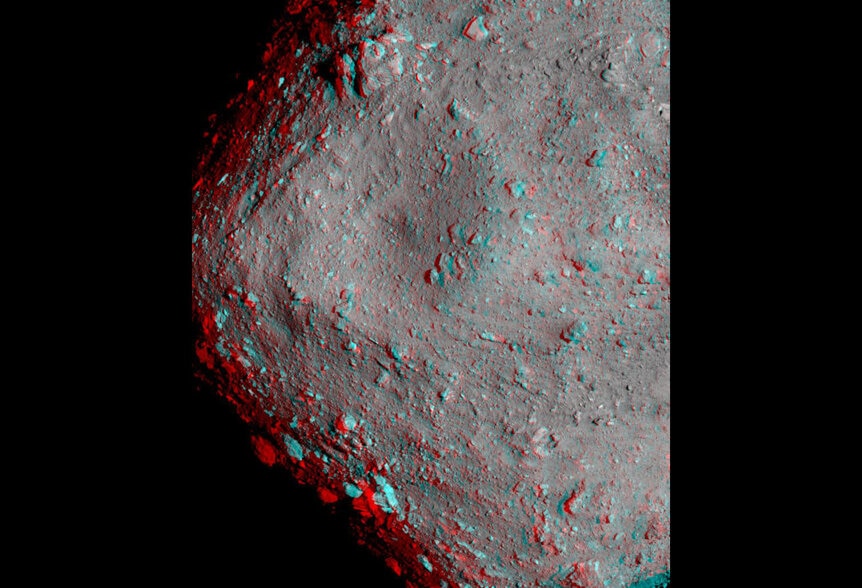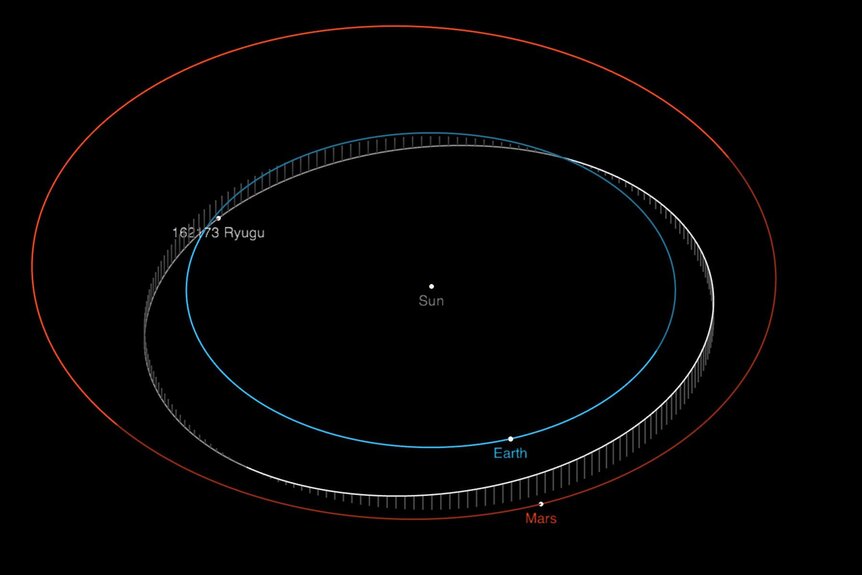Create a free profile to get unlimited access to exclusive videos, sweepstakes, and more!
Mea Culpa: Circling Ryugu

If you are a regular reader, you may know that one thing I try to do here on the BA blog is fess up when I blow it. I make mistakes, and if it’s small I just correct it and note it in the article. But if it’s bigger, something that changes the thrust or conclusion of the article, or just merits more explanation, I post a follow up.
So here I am, posting another mea culpa.
This one involves the weird little asteroid Ryugu, currently being visited by the Japanese spacecraft Hayabusa 2. I’ve written about it a few times, including when the probe was on approach and when it arrived. It was the latter where my mistake began; I said that Hayabusa was orbiting Ryugu. I based this on experience — when a spacecraft gets to where it’s going, it invariably goes into orbit around that target object. In my defense, I had no reason to think otherwise! Also, the Japanese Aerospace Exploration Agency (JAXA) press release mentions the use of “chemical propulsion thrusters for the spacecraft's orbit control”, supporting (though admittedly not confirming) my predisposition.
So in another article I did a bit of math, making some assumptions about the size and density of the asteroid to calculate its mass. Once I had that, I could do all sorts of fun things, including finding out how much I’d weigh on the surface, and, critically in this case, how long it would take Hayabusa 2 to orbit it once.
That’s a straightforward bit of math to do, basically just high school physics (or you can look up the equations online and do some plug-and-chug work). JAXA mentions the “home position” of Hayabusa 2 is 20 kilometers from Ryugu, so I used that as its orbital radius, and found that the spacecraft would take 40 days to circle Ryugu in a circular orbit. That’s pretty slow! But it’s a small, low mass asteroid, so its gravity is weak. That all makes sense, and I was happy.
But then I got an email from Elizabeth Tasker, an associate professor in the Department of Solar System Science at Institute of Space and Astronautical Science / JAXA. She’s part of the outreach team for Hayabusa 2, and she told me I had made a bad assumption: The spacecraft is not in orbit around Ryugu!
That surprised me. She said it has a “synchronized orbit with the asteroid around the Sun”, and I thought she meant it was at the L1 point. This is a special kind of orbit; when you have an object (like the Earth) orbiting a much more massive object (like the Sun), there’s a point in between them where the gravity of each balances (you also have to account for centrifugal force as well). If you put Hayabusa 2 at the right spot, the gravity and orbital forces it feels between the asteroid and the Sun will cancel out, and it’ll stay there.
I asked Dr. Tasker this, and she told me I had assumed wrongly again! I should’ve done the math first. Looking up the equations and doing the math, I find the L1 point is about 70 or so kilometers from Ryugu. But Hayabusa 2 is only 20 km away, so it’s not at the L1 point at all.
It turns out that — get this — Hayabusa 2 just… hovers. At that distance, the gravity of the asteroid is so weak that its grasp on the spacecraft is feeble, and easily compensated for using the thrusters. How about that? In fact, if they just turned the thrusters off and let Hayabusa 2 fall toward the asteroid, it would take about a week to drop down all the way to it*!
So station keeping isn’t that big a problem. Even when the spacecraft dropped down to 6 km above the surface of Ryugu in mid-July to take higher-resolution images, the force on it was pretty much just a whisper, and it could easily maintain that position (that link also talks a bit about the various positions the spacecraft takes in relation to the asteroid… and soon it’ll drop down to a mere 1 km from the asteroid!).
That’s so cool! I’m just not used to spacecraft visiting such teeny objects — even the comet 67/P Churyumov-Gerasimenko, which was 4 km across, had enough gravity that Rosetta had to orbit it (although, to be fair, that was a decidedly odd orbit sometimes). So this was just simply not something that occurred to me.
Weirdly perhaps, I’m happy to have been wrong about this. One of the wonderful things about science (and there are a lot to choose from) is that it shakes you out of your complacency. As I’ve said before, scientists don’t love being wrong, but they do love a puzzle, and when they find out they’ve made a mistake they tend to see it as an opportunity to learn more, to put another piece of that puzzle into place.
I like learning things, and I learned that you don’t always need to circle around something to learn about it. In this case it was easy; I just had to hover around and wait for someone else to issue me a course correction.
*This is called the free-fall time, and the math for that isn’t that hard to plug and chug as well. Incidentally, it would impact very near the escape velocity of Ryugu, which is a paltry 35 centimeters per second. On Earth, I walk much faster than that!





























